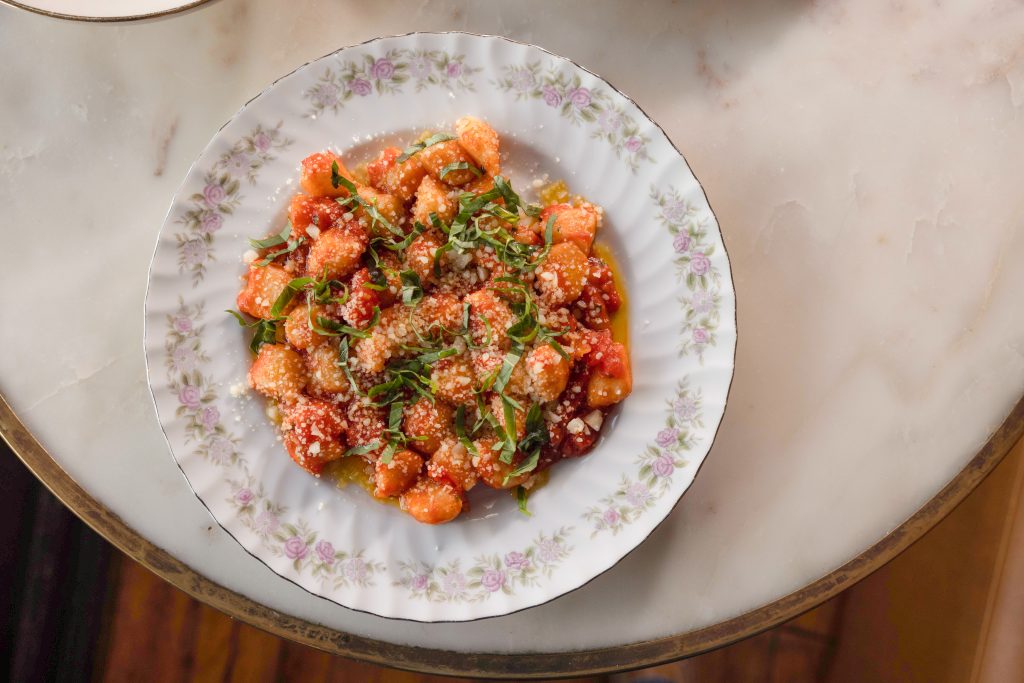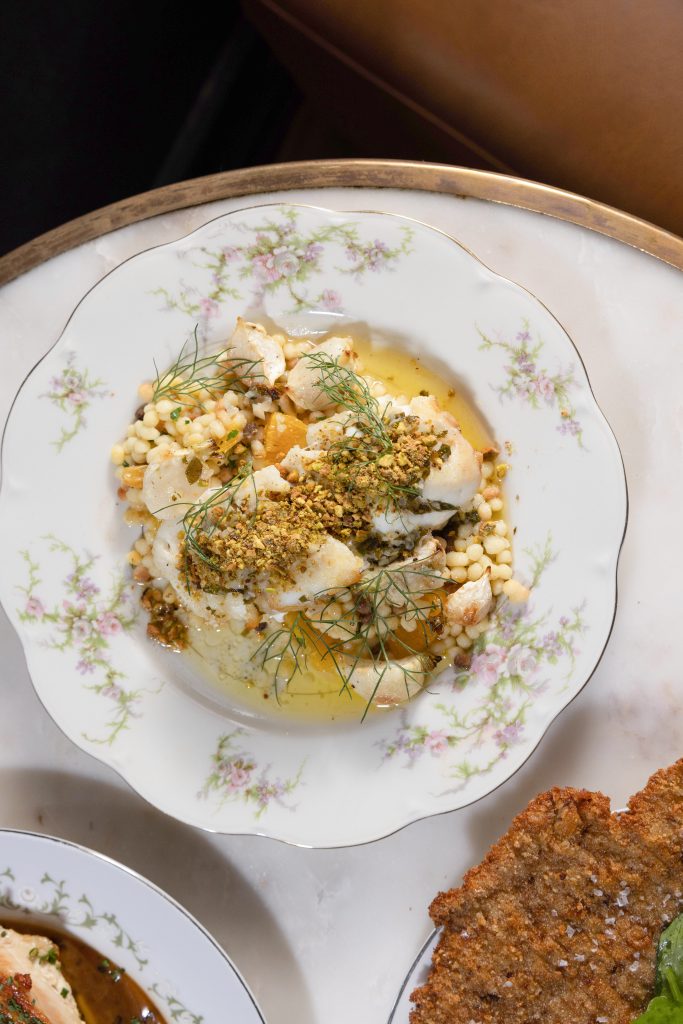Osteria Stella offers a true Northern Italian dining experience

From the bustling Jackson Avenue sidewalk in the Old City, walking into the softly lit, stylishly designed interior of Osteria Stella feels like stepping into another era. It is a contrast to the bright décor of Brother Wolf, its sibling cocktail bar next door. “I wanted to create a dramatic contrast between the two,” says co-owner Jessica Thompson, who also created the speakeasy Peter Kern Library. “I wanted Osteria Stella to be lovely, warm, comfortable, and disarming.”
“It’s romantic and intimate,” agrees Sommelier Brad Poyner, as he demonstrates the technique for folding black napkins into roses. “Some newer Italian restaurants are using a darker and more dramatic approach to set them apart from the traditional white-tablecloth, red-sauce places. We’re not trying to be pretentious—just a different, downtown place for a date or special occasion.” The space is indeed intimate and inviting, with booths for four on one side and banquette tables for two on the other. An eclectic collection of Italian tole chandeliers provides pleasant, diffused light.
Everything in Osteria Stella has a story, starting with its name. Osteria is Italian for a place that serves wine and simple food. Stella is the two-year-old daughter of owners Jessica and Aaron Thompson. Aaron, dapper in a tan suit on the evening of our visit, loves to tell stories, including his courtship of Jessica, which began when he was a bar manager at Sapphire.
“She was a customer,” he laughs. “We did not like each other.” He had earned his history degree from UT in 2007. Bartending at Sapphire, he fell in love with idea of owning a restaurant and, before too long, with Jessica. “Our first trip to Europe I asked Jessica to marry me.” He went down on one knee atop the 1,000-foot cliffs in the Dingle Peninsula in County Kerry, Ireland. Chef de Cuisine Greg Sutton worked at Blackberry Farm eight years under chef Joseph Lenn, then later at Knox Mason. He is delighted to continue that chef-driven tradition.
We began our meal with a glass (or two) of Bianca Vigna Prosecco, the first of the wine pairings suggested by Poyner. We never pass up an opportunity to enjoy polpettine, the small meatballs cooked in wine or broth and served as a main course. Unlike Americans, Italians do not put meatballs on pasta—these delicious beef and pork meatballs are served as a savory starter and are, not surprisingly, a best-seller. The Arancino (rice balls) made with risotto rice, peas, mozzarella, and pickled onion are a perfect complement to the Polpette. We rounded out our starters with a small plate of pillowy soft Mozzarella di Bufala con Zucca, with winter squash, local greens, and charred lemon honey.
Our Primi course began with a lovely Sauvignon Blanc, the 2018 Venezia Giulia IGT, complementing the Bucatini all’ Amatriciana, a deliciously flavorful dish made with guanciale, tomatoes, and Pecorino Romano.

The Lasagna is prepared in the Milanese style, using both Bechamel and Bolognese sauces. If you have never had lasagna prepared this way, you will never look at ricotta and pre-made red sauce the same way ever again. Don’t miss the light and fluffy Gnocchi Burro e Salvia in a butter, sage, and parmesan sauce. We asked Chef Greg his secret—how were they so delicate? “No eggs,” he winked.

Lovers of Italian cuisine will be delighted to see ossobuco on the menu. Ossobuco means “bone with a hole,” and this cross-cut veal shank is braised to fall-off-the-bone tenderness with vegetables, white wine, and broth. It is served in the traditional way, with gremolata, a green sauce of chopped parsley, lemon, and garlic.
There is nothing quite like a good Montepulciano, and the 2019 Reale Abruzzo with its powerful tannins and robust aroma stood up against the ossobuco perfectly. Its deep color with pepper and spice notes gives this wine its “rustic” description.
Branzino, a mild white fish, is popular in Italian cuisine and usually roasted whole and served with lemon. This preparation is paired with cannellini beans, carrots, and pine nuts, which perfectly set off the sweet, flaky meat of the fish. Italians have a way with chicken, and the Pollo al Marsala is no exception. This tender chicken is sautéed in butter, mushrooms, Marsala wine, and “sott olio,” a preservation method meaning “under the oil” which preserves delicate vegetables such as artichokes, olives, asparagus, and mushrooms, in extra virgin olive oil.
If you are looking for something light for dessert, the vanilla Panna Cotta with fruit coulis (a thick fruit sauce) is airy and refreshing. For gelato lovers, the Affogato (which means drowned) al Caffe pairs a lovely vanilla gelato with a shot of espresso. It was difficult to choose a favorite between the cannoli—one with ricotta and pistachio and the other a dreamy hot cocoa and almond. (Spoiler alert: the pistachio was amazing.) Stella’s twist on the classic tiramisu, a confection of mascarpone cheese, ladyfingers, espresso, and cocoa, adds a little Marsala—a wonderful touch. “Tira mi su” is an expression in the Veneto dialect that translates to “pick me up,” and this treat, paired with an after-dinner coffee, did just that.

Comments are closed.